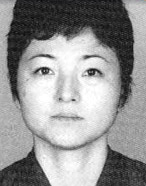 |
||
|---|---|---|
| CP Foundation | About CP Biennale | 2003 | 2005 | Contact Us | >||
           
|
||
|
Following the Western pattern of categorization, textile works in Japan are grouped into the category of craft. Hierarchical matters notwithstanding, to be an artist in the craft category can be advantageous at times. Miyagi, for example, has no qualms in creating functional works. Aside from that, the craft category - which is considered as being closely related with traditional visual arts - gives access to the usage of traditional methods and heritage. Miyagi's works that are made in Okinawa show exactly this. She uses kimono, the traditional Japanese attire, as the means for her artistic explorations. Miyagi also creates many wall-hanging products. For this open biennale, however, she has created a slightly different work. Her installation work for this open biennale is titled "Consist In Time . . . An Ancient Of 1/10000000...," and is dominated by wooden boxes where she displays fibers and samples of clothes. This intentional presentation is highly symbolic. Physically, the textile itself does not appear as the dominating presence. The narration about textile, however, is still dominant in the work. It seems that Miyagi is trying to say that the textile components such as the different fibers, be it natural or synthetic, are important; and that the quality of the cloth is formed and influenced by the quality of its fibers. This particular work also presents a symbolical narration about the creative patterns of the artist, who believes that explorations in creating the cloth, by means of small samples, are very important. From such samples, Miyagi recognizes, becomes intimate with, and guess at the quality of the cloth, until she then decides to create the large piece of the cloth. Therefore, this particular work becomes special as it tells of, and symbolizes, the long journey that a piece of cloth has taken. This represents the respect and the sacrifices of the artist in creating her works. Such belief is prevalent among craft artists. However, Miyagi also realizes that most people will judge and appreciate merely the finished product. That is why she hangs her textile work in the central position, on the main panel, while the small boxes displaying the fibers and the samples lie below it. Asmudjo Jono Irianto Born on December 20, 1968 in Kijoka, Oogimi, Okinawa, Japan. SELECTED GROUP EXHIBITIONS |
||
|
CP Foundation | About CP Biennale | 2003 | 2005 | Contact Us
Jl. Suryopranoto 67A, Jakarta 10160, Indonesia. ph. +62.21.3448126, 3853206 | fax. +62.21.3853203, 3853208 info@cp-foundation.org |
||
 Nana Miyagi's attention to the quality and characters of textiles betrays her cultural background as a Japanese. The Japanese is indeed renowned with their penchant for getting to know and dwelling on the characters of a material. This is obvious in the richness and the quality of the material culture in the traditional Japanese, which is now manifested in the modern material culture through the industrial products, contemporary art, and contemporary craft. Nana Miyagi is a textile artist whose works reveal her sensitivity about the quality of the materials she works with - in this case fibers and clothes. Miyagi is mostly interested in the tactile quality of clothes. She believes that such tactile sensitivity helps a textile artist to create visually captivating works. Naturally, the visual characters at play here are very vague, as they deal with the soft texture of clothes. This is exactly the strength and specialty of textile artists: their subtle sensitivity.
Nana Miyagi's attention to the quality and characters of textiles betrays her cultural background as a Japanese. The Japanese is indeed renowned with their penchant for getting to know and dwelling on the characters of a material. This is obvious in the richness and the quality of the material culture in the traditional Japanese, which is now manifested in the modern material culture through the industrial products, contemporary art, and contemporary craft. Nana Miyagi is a textile artist whose works reveal her sensitivity about the quality of the materials she works with - in this case fibers and clothes. Miyagi is mostly interested in the tactile quality of clothes. She believes that such tactile sensitivity helps a textile artist to create visually captivating works. Naturally, the visual characters at play here are very vague, as they deal with the soft texture of clothes. This is exactly the strength and specialty of textile artists: their subtle sensitivity.